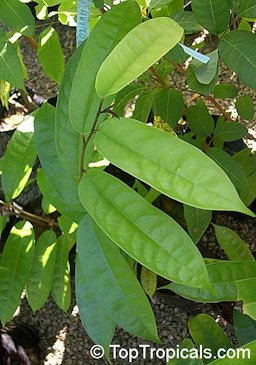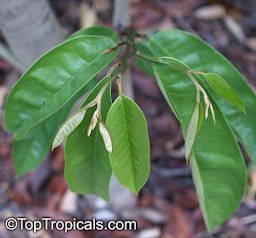| Poshte - Annona scleroderma | |||||
|---|---|---|---|---|---|
 Fig. 1  Annona scleroderma  Fig. 2   Fig. 3 New growth  Fig. 4  |
Scientific
name Annona scleroderma Scaff. Common names English: poshte, posh-te; Spanish: chirimoya, anona del monte; other: cawesh, cahuex, poshté Synonyms A. liebmanniana Baill., A. testudinea Saff. Relatives Ilama (A. diversifolia), pond apple (A. glabra), manrito (A. jahnii), mountain soursop (A. montana), soursop (A. muricata), soncoya (A. purpurea), bullock's heart (A. reticulata), sugar apple (A. squamosa), atemoya (A. cherimola x A. squamosa) Family Annonacaea (annona family) Origin Native range is the Atlantic coast of Central America, from Mexico and Guatemala to Honduras Uses Food Height To 65 ft (20 m) Spread 30 ft (9 m) 1 Growth rate Vigorous Trunk/bark/branches Heavily branched;the first branches starting 8-12 ft (2.5-3.7 m) from the ground; trunks up to 1½ ft (0.45 m) thick 1 Pruning requirement Very large tree that need hard pruning to keep the fruit accessible Leaves Large, thick, glabrous, oblong leaves Flowers Small cinnamon-brown; flowers on the previous year's growth Fruit Pineapple-banana flavor; very smooth, creamy flesh, easily spooned out from the hard skin and effortlessly slipping off the shiny seeds; thick, relatively hard shell 1 Season Dec. to Apr. Light requirement Shade when young, older trees need sunny location 5 Soil tolerances Prefers rich, loamy, well drained soil 5 pH preference 5.5-6.5, tolerating 4.5 -7 5 Reading Material Annona scleroderma, Neglected Crops Poshte, Manual Of Tropical And Subtropical Fruits The CAWÉSH, Archives of the Rare Fruit Council of Australia Origin Its native range is the Atlantic coast of Central America, from Mexico and Guatemala to Honduras. It is not widely cultivated (except in certain parts of Guatemala).
A. scleroderma is one of the least-known fruit trees of the genus; it is grown mainly in southwestern Guatemala and is notable for the structure of its fruit which, unlike the other cultivated species, has a very tough skin, allowing it to be handled much more easily and making it resistant to insect attack. The fruit may be cut and the flesh removed with a spoon. Its potential value is in its high-quality flesh, hard skin and high yield. It could become an export item and a product for wide local consumption. 2 Description A. scleroderma is a tall tree which reaches 15 to 20 m and has tough, lanceolate leaves measuring 10 to 25 x 5 to 8 cm. They are shiny on the upper side, slightly pubescent on the underside and have fragile, 3 cm long petioles. 2 Most of the foliage is on the outer one or two yards-worth of the branches; the mostly bare inner part of the treetop is where the flowers and heavy crops of fruits form directly from the sturdy, middle-aged branches, much as mamey sapotes do. 1 Leaves The mature leaves are long, stiff, thick, and waxy-shiny on top, and ever-so-slightly rusty underneath, this rustiness easily visible only on the midrib when the leaves are mature; the small, closed new growth is felty-rusty, but quickly turns a shiny light-green-yellow when it opens and expands. 1 "I have picked a leaf. It is dark green and shiny. The underside of the leaf is without the polished shine; it is of a paler green with a touch of browny-gold. The underside veins are greeny-yellow. The leaf measures from end to end 22cm long and 7.5cm wide (8¾ inches by 3¼ inches). The leaves look like soursop leaves, but the posh-té leaves are at least twice as large. (The soursop tree has lost many leaves, baring branches this winter; the posh-té has not lost any leaves)." Christine Gray 4 Flowers The flowers are greenish yellow, the outer petals have a longitudinal prominence which arises in the small branches or in groups in the old part of the thick branches. 2 The flowers of the posh-té are much like a custard apple flower, but the petals are slightly brown-tinged, and seem to be longer than a custard apple flower. 4 Fruit The fruit is roundish oblate in form, about 3 inches in diameter, with a dull green surface divided into areoles by small ridges, the shell being nearly ¼-inch thick. The seeds, which are embedded in the white melting pulp, are about the same size as those of the cherimoya. 3 The advantages of A. scleroderma as a fruit for local consumption and export are its high productivity and the fact that the flavour and aroma of its flesh are not as strong as in other Annona species, but are different and pleasant. The abundant, cream-coloured or creamy grey flesh separates easily from the seeds and it does not have sandy grains or fibres that adhere to the seed membrane. The thick, leathery skin does not split and is very resistant to insect attack and ordinary packaging and transport. 2 When the fruit set, they set on branches in small clusters of two or three fruits. This causes smaller fruit to form. Thinning out the fruit would be a good practice to adopt, to encourage larger fruit. 4 The fruit occurs in compact spherical groups, is 5 to 10 cm in diameter and generally falls off when ripe, without a noticeable colour change. 2 Harvesting The skin of the posh-té fruit stays green. We have found it is best picked when the fruit is well filled out and the markings on the skin flatten out. Take inside and leave to ripen, similar to a custard apple. 3 Propagation Unlike the seeds of many other Annona species, fresh cawésh seeds germinate readily - 90% in one month - without any pre-planting treatment. Seeds that have been stored for two to three months need about six months to germinate. Trees grown from seed begin to produce at around tour years when they reach a height of 4 to 6 m. 1,2 In Australia, A. scleroderma grows well when grafted on to stocks of A. muricata and Rollinia mucosa. 2 Grafting Annonas in Southern Florida, Hort Science pdf
Pruning When grafted material is planted. it must be borne in mind that the trees should be pruned so that a wide crown remains to facilitate fruit harvesting. This also reduces exposure to wind and bird damage. 2 Food Uses Fresh out of hand General "Just got to taste my first poshte (Annona scleroderma). The trees have fruited a couple of years already but the fruits got stung by chalcyd wasp. I netted some of the fruits last year but too late as they get stung quite small. This year i managed to get a bag on one in time. The taste was surprisingly good. Really delicious. The fruit was already blackened on the outside and i thought it was probably over ripe. But it was just perfect inside. The taste is like cherimoya, mixed with apple sauce, and a tiny bit of lemony taste. A perfect balance of sweet and a tad of tart, so that the taste is not overly sweet, like some cherimoyas. Much more juicy than cherimoya and the texture is softer. As you can see the pulp is yellowish. This fruit is probably smaller than normal." Oscar Jaitt, fruitlovers.com Other Edibles in the Annona genus: Atemoya (A. cherimola x A. squamosa) Biriba (Rollinia mucosa, A. mucosa) Cherimoya (A. cherimola) Custard Apple (A. reticulata) Ilama (A. macroprophyllata) Mountain Soursop (A. montana) Pond Apple (A. glabra) Soursop (A. muricata) Sugar apple (A. squamosa) Further Reading “Correct to a TE”, Archives of the Rare Fruit Council of Australia An Update on the Posh-Te, Archives of the Rare Fruit Council of Australia The Survival of the Posh-Te, Archives of the Rare Fruit Council of Australia List of Growers and Vendors |
||||
| Bibliography 1 Mahdeem, Har. "The CAWÉSH." Archives of the Rare Fruit Council of Australia, May. 1990, rfcarchives.org.au. Accessed 9 Apr. 2015. 2 Mahdeem, H. "Custard Apples." Neglected crops: 1492 from a different perspective, FAO Plant Production and Protection Series, no. 26. Food and Agriculture Organization of the United Nations, 1994, FAO, fao.org. Accessed 26 Dec. 2016. 3 Gray, Christine. "Correct to a TE." Archives of the Rare Fruit Council of Australia, Mar. 1990, rfcarchives.org.au. Accessed 9 Apr. 2015. 4 Gray, Christine. "An Update on the Posh-te." Archives of the Rare Fruit Council of Australia, Sept. 1990, rfcarchives.org.au. Accessed 9 Apr. 2015. 5 Fern, Ken. "Annona scleroderma." Plants for a future, (CC BY-NC-ND 3.0), pfaf.org/user/Plant.aspx?LatinName=Annona+scleroderma. Accessed 14 Aug. 2021. Video v1 "Annonas with Har, Introduction." Truly Tropical Farms, 6 Jan. 2021, (CC0), www.youtube.com/watch?v=V-0JiXT7s5s. Accessed 7 Aug. 2021. v2 "How to Graft Annona Fruit Trees Using Cleft Graft - Grafting Dream Cherimoya, Atemoya, etc." Sulcata Grove, 26 Feb. 2017, www.youtube.com/watch?v=1_Xy-rZQmdg. Accessed 23 July 2021. Photographs Fig. 1 "Annona scleroderma." Fruitlovers, 2015, fruitlovers.com. Accessed 10 Feb. 2016. Fig. 2,3,4 "Annona scleroderma." Top Tropicals, toptropicals.com. Accessed 11 Apr. 2015. Published 12 Apr. 2014 LR. Last update 27 Aug. 2021 LR |
|||||